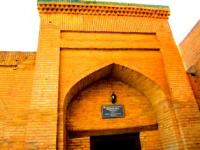You are here
Bikajan Bika Madrasah.

Religious tours on madrasahs and to necropolises of Khiva.
"The injustice that fate has committed will be asked,
A sultan of generosity will apologize for her.
Spilled my cup, oh kravchy, although it was not full.
In this circle, my spilled cup should be filled to the brim "
Khoja Abul-l-Barakat-i Firaki.
City break in Khiva.
The cult ensemble composed of madrassah, mosques and minaret was founded on the ancient territory near the mausoleum of Shoqalandar Bobo, revered among the people and which is a part of the ensemble.
Shoqalandar Bobo according to legend was a ruler and having abandoned the reign he became a wandering dervish (Qalandar). Having come to Khiva together with two dervishes, he stayed to live here.
After the death of Shoqalandar Bobo his students erected a mausoleum over his grave which became a revered place. According to historical data, the mausoleum was built in the sixteenth century. In 1894 a madrassah, a mosque and a minaret were constructed near the mausoleum.
From the oral legends of old residents the name of the master (Usto) Abul became known, who constructed the building of the ensemble. According to the story the of old-timers the construction of the madrasah and the minaret was initiated by the younger sister of Muhammad Rahimkhan II Feruz, Bikajan-Bika.
But it turned out that she started the construction without Khan’s permission for that. Having found it out the enraged Khan ordered to stop the construction. Some time later the Khan regretting his decision ordered to continue construction of the madrassah.
But the funds to continue the construction works were not enough. Then Muhammad Rahimkhan II Feruz enjoined Rahmatullah yasaulbashi to add up their money with funds of Bikajan-Bika and finish the construction of the madrassah.
Thus it was possible to complete the construction of the madrassah and the minaret. The ensemble is oriented to the north by the principal façade consists of a single-storey madrassah square in the general plan, but with a transverse layout of the yard and asymmetrical compositions of the entrance group.
Entrance into it lays through the three domed lobby, to the cranked passes through the row of the domed compartments. Premises of darskhana and mosque are various in architecture: the darskhana is overlapped by a girder roof and mosque by a massive spheroconical calotte.
Entrances from the lobby are shifted towards the principal facade. Rectangular Hujras are roofed with the vault of "Balkhi" style in the beveled corners of the yards with faceted niches placed are entrances to a couple of hujras - angular enhanced in size and ordinary ones.
The main facade facing the north architecturally designed independently of the structure of buildings hidden behind it: on both sides of the narrow Khorezmi portal crowned with a pattern "Sharaf", at the corners turrets "guldasta" are located, on the surface of which green "ribbons" are sprinkled.
Mausoleum Shoqalandar Baba originally was a three-chambered with pilgrims’ room and two burial vaults behind it. Nowadays there remained only ziyaratkhana (pilgrims’ room) in the form of a domed building with a protruding portal.
Dimensions of madrassah in general plan – 32,0 х 32,0 meters; diameter of a minaret at the base – 6,5 meters, height – 18 meters. The mausoleum – 6,2 to 6,2 meters; the chamber – 4,0 х 4,0 meters.
Authority:
http://welcomeuzbekistan.uz







